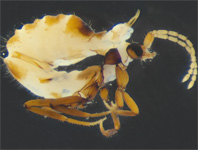Abstract
Ototyphlonemertes longissima sp. nov is described from the South China Sea. The present species, up to 158 mm long, is about three times longer than the longest previously reported individual known in the genus. It possesses a narrow stylet basis, a bulbous proboscis diaphragm, a long middle proboscis chamber, sculptured stylets, polygranular statocysts and excretory tubules, and thus belongs to the O. macintoshi species group. The genetic divergence (average uncorrected p-distance) between O. longissima (representing a unique network in TCS analysis) and the other species (TCS networks) of genus Ototyphlonemertes is 0.135–0.185.
References
Bürger, O. (1895) Die Nemertinen des Golfes von Neapel und der angrenzenden Meeres-Abschnitte. Fauna und Flora des Golfes von Neapel, 22, 1–743.
Chernyshev, A.V. (1998) New data on interstitial nemerteans of the family Ototyphlonemertidae (Enopla, Monostilifera) from the Sea of Japan. Zoologicheskiĭ Zhurnal, 77 (3), 268–269. [in Russian with English abstract]
Chernyshev, A.V. (2003) Ototyphlonemertes valentinae sp. n. (Enopla, Ototyphlonemertidae) is an interstitial nemertean from the Sea of Japan. Zoologicheskiĭ Zhurnal, 82 (7), 868–871.
Chernyshev, A.V. (2007) Nemerteans of the Genus Ototyphlonemertes (Enopla: Ototyphlonemertidae) from Van Phong Bay (South Vietnam). Russian Journal of Marine Biology, 33 (3), 196–199.
https://doi.org/10.1134/S1063074007030091
Clement, M., Posada, D. & Crandall, K.A. (2000) TCS: a computer program to estimate gene genealogies. Molecular Ecology, 9 (10), 1657–1659.
https://doi.org/10.1046/j.1365-294x.2000.01020.x
Coe, W.R. (1940) Revision of the nemertean fauna of the Pacific coasts of North, Central and northern South America. Reports of Allan Hancock Pacific Expedition 1932–38, 2 (13), 247–323.
Coe, W.R. (1943) Biology of the nemerteans of the Atlantic coast of North America. Transactions of the Connecticut Academy of Arts and Sciences, 35, 129–328.
Corrêa, D.D. (1954) Nemertinos do litoral Brasileiro. Boletim da Faculdade de Filosofia, Ciências e Letras, Universidade de São Paulo, 19, 1–90.
https://doi.org/10.11606/issn.2526-3382.bffclzoologia.1954.120084
Diesing, K.M. (1863) Nachträge zur Revision der Turbellarien. Sitzungsberichte der Akademie der Wissenschaften in Wien, Mathematisch-Naturwissenschaftliche Klasse, 46, 173–188.
Envall, M. (1996) Ototyphlonemertes correae sp. nov. and a redescription of O. duplex (Nemertea: Monostilifera: Ototyphlonemertidae ), with a phylogenetic consideration of the genus. Journal of Zoology, 238 (2), 253–277.
https://doi.org/10.1111/j.1469-7998.1996.tb05393.x
Envall, M. & Norenburg, J.L. (2001) Morphology and systematics in mesopsammic nemerteans of the genus Ototyphlonemertes (Nemertea, Hoplonemertea, Ototyphlonemertidae). Hydrobiologia, 456 (1–3), 145–163.
https://doi.org/10.1023/a:1013029310452
Folmer, O., Black, M., Hoeh, W., Lutz, R. & Vrijenhoek, R. (1994) DNA primers for amplification of mitochondrial cytochrome c oxidase subunit I from diverse metazoan invertebrates. Molecular Marine Biology and Biotechnology, 3, 294–299.
Gerner, L. (1969) Nemertinen der Gattungen Cephalothrix und Ototyphlonemertes aus dem marinen Mesopsammal.Helgoländer wissenschaftliche Meeresuntersuchungen, 19 (1), 68–110.
https://doi.org/10.1007/BF01625860
Kajihara, H. (2007) Ototyphlonemertes dolichobasis sp. nov. (Nemertea: Hoplonemertea: Monostilifera: Ototyphlonemenidae), a new species of interstitial nemertean from Japan. Species Diversity, 12 (1), 57–66.
https://doi.org/10.12782/specdiv.12.57
Kajihara, H., Tamura, K. & Tomioka, S. (2018) Histology-free descriptions for seven species of interstitial ribbon worms in the genus Ototyphlonemertes (Nemertea: Monostilifera) from Vietnam. Species Diversity, 23, 13–37.
https://doi.org/10.12782/specdiv.23.13
Librado, P. & Rozas, J. (2009) DnaSP v5: a software for comprehensive analysis of DNA polymorphism data. Bioinformatics, 25 (11), 1451–1452.
https://doi.org/10.1093/bioinformatics/btp187
Stamatakis, A. (2014) RAxML version 8: a tool for phylogenetic analysis and post-analysis of large phylogenies. Bioinformatics, 30 (9), 1312–1313.
https://doi.org/10.1093/bioinformatics/btu033

